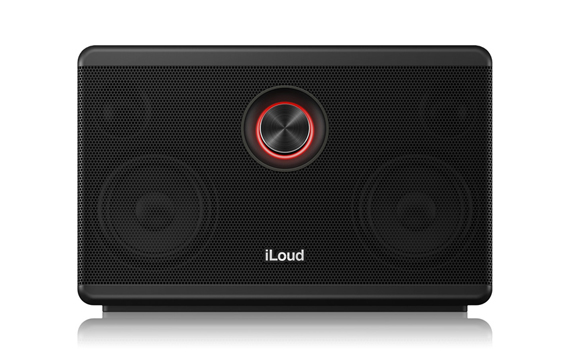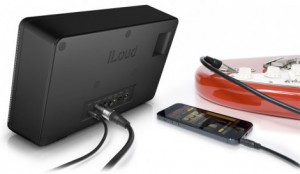Review: IK Multimedia iLoud
There is no doubt that audio technology has become less expensive, more transparent, more powerful and more portable. In terms of real cost-to-performance, anywhere from a few hundred to a few thousand dollars can get you a lot more in a set of professional studio monitors than at any other point in history. Perhaps it’s about time that consumer-focused systems started to catch up as well.
The new iLoud by IK Multimedia ($299) is one such attempt to bring studio-quality sound to consumers, musicians and hobbyists while providing features that are relevant to many of today’s listeners. Its makers have included wireless Bluetooth connectivity, a rechargeable battery, even a guitar input and modeling software that can turn this portable, wireless device from a 40-watt stereo system into a 21st century practice amp.
IK Multimedia has marketed this simple-looking black box as “The first studio-quality portable speaker designed for musicians and audiophiles.” And we thought we’d just have to see about that.
Appearance and Build Quality
Out of the box, the iLoud felt strong, sturdy, and appropriately heavy, while still remaining light enough to throw into a knapsack and carry around. A good thing, as that’s one of the main points of the device: To be rugged and portable as well as good sounding – a rare goal for a prosumer stereo speaker.
In this focus on sturdiness, sound and features, however, IK Multimedia may have skimped a bit when it came to the consideration of visual aesthetics. The look of the iLoud is decidedly spartan and monolithic-looking, and at first I found the unit and its glowing ring of red light even a bit ugly and unnerving. But within a few short days it started to disappear into the background. (I was reminded of the story about how coarse and industrial-looking the Aeron chair was considered when it was first introduced, and how few of us even notice them now.)
Features
There is very little that is conventional about the features built into the iLoud. Sure, it’s a small, stereo self-powered speaker with both Bluetooth and 1/8”. But how many are you aware of that put out 40-watts of bi-amped power through 4 drivers, include a rechargeable battery, a dedicated guitar input, and the ability to integrate with iOS apps that promise to turn your new speaker into a self-powered modeling amp?
In order to use the iLoud as a guitar amp, one can simply plug in the guitar to one jack, an Apple iOS device to the other, and then run one of IK Multimedia’s modelers, such as Amplitube Free. For portable listening, the battery is spec’d to last for about 3-10 hours of continuous use, depending on your volume level.
The Bluetooth input uses the A2DP protocol, which offers enough bandwidth that the wireless stream should be effectively transparent to the ear with a range up to about 30 feet under ideal conditions.
Sound
The real test of course, is the ear test. For a box of such compact size, I was surprised to find out that the iLoud goes as deep as 50Hz, thanks to some clever cabinet design. Even with such a suggestive name, it does go surprisingly loud, and stays surprisingly clean while doing so. I found it was able to comfortably put out 90dB without a hint of distortion, and responded well to dynamic material. It sounds big on bottom, clear on top and well-balanced through the middle. Smooth and a bit tailored without sounding overly “scooped.” I wouldn’t consider it a replacement for a set of great studio monitors, but you could sure do a lot worse.
My small quibbles with sound are the kinds of complaints only an audio engineering nerd would be likely to make: With low frequency drivers just 3” in diameter and a single rear port, there’s obviously going to be some kind of tradeoff in terms of low-frequency resonance.
In IK’s defense, this tradeoff was far less significant than expected, but it was there: A subtle, low-end tonal color that only total sound geeks like myself would be likely to hear and grumble about. This was not so serious as to be of true “one note bass” proportions, but on some complex basslines, an especially critical listener might notice some notes jump out a bit more than others.
This kind of thing is to be expected in any system this size, especially if it aspires to go this deep. But considering the compact dimensions they’re working with, IK Multimedia did much better in this department than many. With the iLoud you get deep, full-sounding bass that’s not too boomy or “note-y,” even when cranked loud. (I just wouldn’t use it as a sole mix reference in a professional environment.)
The top end on the iLoud is clear, bright and open without ever sounding sizzly, spitty or strained. The one quibble I’d have here is that the tweeters are spaced so wide as to make it an awkward listen up close where one might think to put traditional desktop speakers.
If you’re less than 3 feet away, this unusual tweeter spacing can make the stereo image seem to swim and lack a concrete center. But from further away, this liability becomes an asset, helping the iLoud stay suitably stereo-sounding as it fills the whole room with music. And it’s in this kind of medium- to long-distance listening scenario that the iLoud stands up particularly well to other small stereo systems, even many bigger ones.
Syncing via Bluetooth was a snap, and is probably one of my favorite features of the unit. Bluetooth connectivity has come a long way in recent years, and I found the A2DP protocol to be pleasantly transparent when streaming music from my cellphone from up to about 30 feet away.
I had a little less luck with a recent Mac laptop (presumably due to a less powerful built-in antenna) and needed to remain within about 10-15 feet in order avoid dropouts, timing and pitch artifacts from poor connectivity. Spending less than $10 on a plug-in Bluetooth antenna would have likely solved this issue and given me as much range as the cellphone.
The freedom and convenience of not having to wait to get to the studio, move to a different room, or to even step out of my chair and plug in to stop listening on built-in laptop speakers and start listening on a decent-sounding casual reference system was perhaps my favorite thing about the iLoud. It’s a simple luxury I’d definitely pay a few hundred dollars for.
Whether the iLoud will become a leading choice in that department remains to be seen. But currently, it faces an unsaturated and fairly uncompetitive field, and stands as one of the better-sounding compact wireless speaker systems around. It’s also unlikely that any casual listener would be disappointed by the sound. Some professional studio nerds might even find themselves feeling the same way.
Please note: When you buy products through links on this page, we may earn an affiliate commission.










A-Bomb
December 19, 2013 at 7:30 pm (11 years ago)nice review and interesting product, thanks